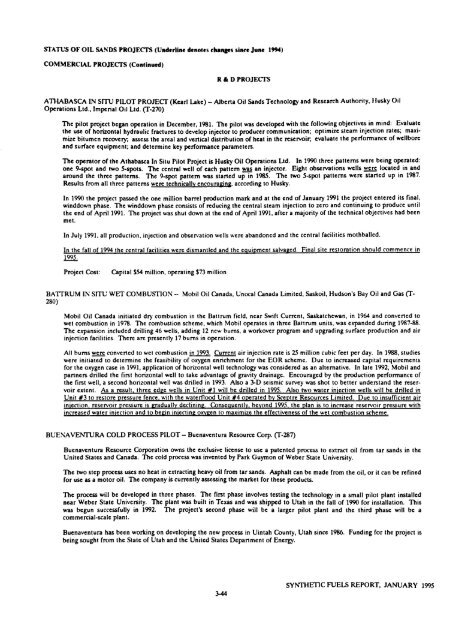Ikelic - Alliance Digital Repository
Ikelic - Alliance Digital Repository
Ikelic - Alliance Digital Repository
You also want an ePaper? Increase the reach of your titles
YUMPU automatically turns print PDFs into web optimized ePapers that Google loves.
STATUS OF OIL SANDS PROJECTS (Underline denotes changes since June 1994)<br />
COMMERCIAL PROJECTS (Continued)<br />
ATHABASCA IN SITU PILOT PROJECT (Kearl Lake)<br />
Operations Ltd., Imperial Oil Ltd. (T-270)<br />
R&D PROJECTS<br />
- Alberta Oil Sands Technology and Research Authority, Husky Oil<br />
The pilot project began operation in December, 1981. The pilot was developed with the objectives following in mind: Evaluate<br />
the use of horizontal hydraulic fractures to develop injector to producer communication; optimize steam injection rates; maxi<br />
mize bitumen recovery,<br />
assess the areal and vertical distribution of heat in the reservoir, evaluate the performance of wellbore<br />
and surface equipment; and determine key performance parameters.<br />
The operator of the Athabasca In Situ Pilot Project is Husky Oil Operations Ltd. In 1990 three patterns were being operated:<br />
one 9-spot and two 5-spots. The central well of each pattern was an injector. Eight observations wells were located in and<br />
around the three patterns. The 9-spot pattern was started up in 1985. The two 5-spot patterns were started up in 1987.<br />
Results from all three patterns were technically encouraging, according to Husky.<br />
In 1990 the project passed the one million barrel production mark and at the end of January 1991 the project entered its final,<br />
winddown phase. The winddown phase consists of reducing the central steam injection to zero and continuing to produce until<br />
the end of April 1991. The project was shut down at the end of April 1991, after a majority of the technical objectives had been<br />
met.<br />
In July 1991, all production, injection and observation wells were abandoned and the central facilities mothballed.<br />
In the fall of 1994 the central facilities were dismantled and the equipment salvaged. Final site restoration should commence in<br />
1995.<br />
Project Cost: Capital $54 million, operating $73 million<br />
BATTRUM IN SITU WET COMBUSTION - Mobil<br />
280)<br />
Oil Canada, Unocal Canada Limited, Saskoil, Hudson's Bay Oil and Gas (T-<br />
Mobil Oil Canada initiated dry combustion in the Battrum field, near Swift Current, Saskatchewan, in 1964 and converted to<br />
wet combustion in 1978. The combustion scheme, which Mobil operates in three Battrum units, was expanded during 1987-88.<br />
The expansion included drilling 46 wells, adding 12 new burns, a workover program and upgrading surface production and air<br />
injection facilities. There are presently 17 burns in operation.<br />
All burns were converted to wet combustion in 1993. Current air injection rate is 25 million cubic feet per day. In 1988, studies<br />
were initiated to determine the feasibility of oxygen enrichment for the EOR scheme. Due to increased capital requirements<br />
for the oxygen case in 1991, application of horizontal well technology was considered as an alternative. In late 1992, Mobil and<br />
partners drilled the first horizontal well to take advantage of gravity drainage. Encouraged by the production performance of<br />
the first well, a second horizontal well was drilled in 1993. Also a 3-D seismic survey was shot to better understand the reser<br />
voir extent. As a result, three edge wells in Unit #1 will be drilled in 1995. Also two water injection wells will be drilled in<br />
Unit #3 to restore pressure fence, with the waterflood Unit #4 operated by Sceptre Resources Limited. Due to insufficient air<br />
injection, reservoir pressure is gradually declining. Consequently, beyond 1995. the plan is to increase reservoir pressure with<br />
increased water injection and to begin injecting oxygen to maximize the effectiveness of the wet combustion scheme.<br />
- BUENAVENTURA COLD PROCESS PILOT Buenaventura<br />
Resource Corp. (T-287)<br />
Buenaventura Resource Corporation owns the exclusive license to use a patented process to extract oil from tar sands in the<br />
United States and Canada. The cold process was invented by Park Guymon of Weber State University.<br />
The two step process uses no heat in extracting heavy oil from tar sands. Asphalt can be made from the oil, or it can be refined<br />
for use as a motor oil. The company is currently assessing the market for these products.<br />
The process will be developed in three phases. The first phase involves testing the technology in a small pilot plant installed<br />
near Weber State University. The plant was built in Texas and was shipped to Utah in the fall of 1990 for installation. This<br />
was begun successfully in 1992. The project's second phase will be a larger pilot plant and the third phase will be a<br />
commercial-scale plant.<br />
Buenaventura has been working on developing the new process in Uintah County, Utah since 1986. Funding for the project is<br />
sought being from the State of Utah and the United States Department of Energy.<br />
S44<br />
SYNTHETIC FUELS REPORT, JANUARY 1995















![pace SrntfletIc fne]its report - Alliance Digital Repository](https://img.yumpu.com/10493335/1/190x245/pace-srntfletic-fneits-report-alliance-digital-repository.jpg?quality=85)
